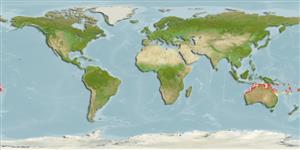Elasmobranchii (sharks and rays) >
Carcharhiniformes (Ground sharks) >
Carcharhinidae (Requiem sharks)
Etymology: Carcharhinus: Greek, karcharos = sharpen + Greek, rhinos = nose (Ref. 45335).
Environment / Climate / Range
Ecology
Marine; brackish; demersal; depth range 0 - 40 m (Ref. 6871). Subtropical, preferred ?; 10°S - 26°S
Western Pacific: northern Australia, from Western Australia to Queensland. Recorded in the Arafura Sea (Ref. 9819).
Length at first maturity / Size / Weight / Age
Maturity: Lm ?, range 89 - 100 cm
Max length : 135 cm TL male/unsexed; (Ref. 6871)
A little-known shark found inshore and offshore on the continental shelves from the intertidal to at least 40 m depth (Ref. 9997). Feeds mainly on teleost fishes, also crustaceans (Ref. 6871). Viviparous (Ref. 50449). Utilized for human consumption (Ref. 244, 9997) and probably for the oriental shark fin trade (Ref. 244).
Viviparous, placental (Ref. 50449). Females give birth to 1-7 pups every year between February and May (Ref. 6871). Size at birth about 50 cm (Ref. 6871). Distinct pairing with embrace (Ref. 205).
Compagno, L.J.V., 1984. FAO Species Catalogue. Vol. 4. Sharks of the world. An annotated and illustrated catalogue of shark species known to date. Part 2 - Carcharhiniformes. FAO Fish. Synop. 125(4/2):251-655. Rome: FAO. (Ref. 244)
IUCN Red List Status (Ref. 115185)
CITES (Ref. 94142)
Not Evaluated
Threat to humans
Harmless
Human uses
Fisheries: minor commercial
More information
ReferencesAquacultureAquaculture profileStrainsGeneticsAllele frequenciesHeritabilityDiseasesProcessingMass conversion
Tools
Special reports
Download XML
Internet sources
